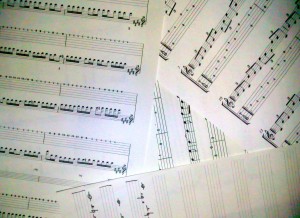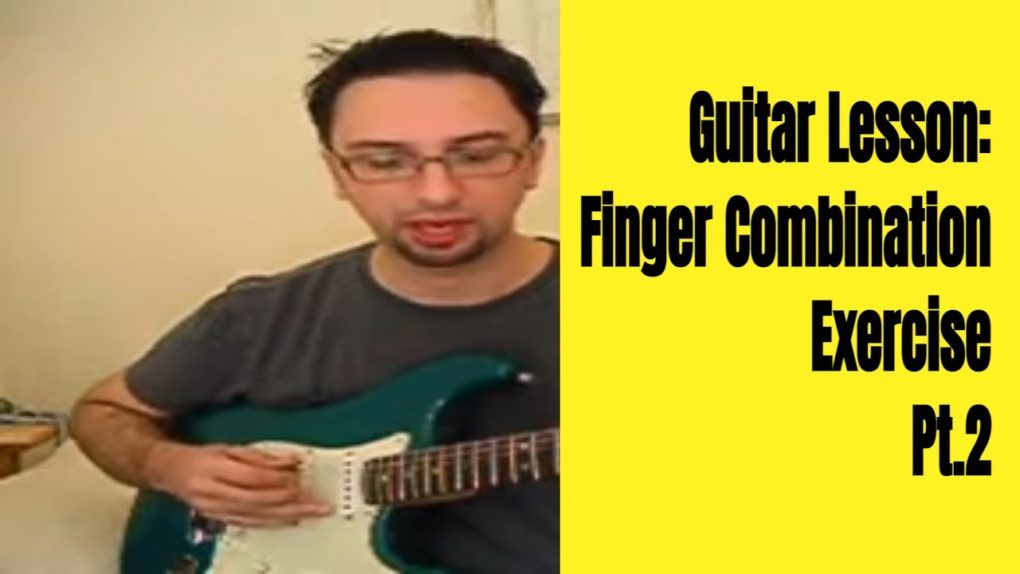First of a series of exercises to improve your knowledge of the fretboard.


First of a series of exercises to improve your knowledge of the fretboard.
I have had a lot of positive feedback about this section from my book ‘Contemporary Blues Soloing‘ and many suggested to share it on-line. I renamed this post ‘Build your own musical vocabulary’
The eBook is available here: http://goo.gl/M4nlak
Or on Amazon: http://goo.gl/32fxmh
 “…I always felt that one of the common threads whilst I was learning to
“…I always felt that one of the common threads whilst I was learning to
play guitar, was the repertoire: whether to do with songs, phrases,
sounds, exercises. So transcribing has always been a key element of my
practice routine. Whether you write things down on paper, with
traditional notation or tabs, transcribing is one of those skills that will
challenge you on many levels: it will test your aural skills (recognizing the
notes by ear) and your knowledge of the instrument. It will also test your
knowledge of theory in the moment you try to understand what those
sounds mean. This last step is usually overlooked. I have taught
hundreds of students and have found a common problem: they could
learn a song or a solo parrot-fashion, without knowing why the guitarist
(or musician) picked those very notes. The moment I ask a student to
explain what key the song is in, or to explain the note choice, is usually
followed by dead silence.
We all have a ‘sound’. We are all unique. I am sure if you invite over a
few fellow guitarists and record a jam, you will be able to recognize
yourself playing in an instant. Unfortunately in our early years we are
more likely to imitate our heroes, trying to copy every move, technique
and gadget they use. The marketing machine also feeds this behaviour
as many brands can sell their product by giving endorsements to those
artists. I am not saying this is a negative thing, because this is how we
learn to love the instrument. Having said that, you will get to the point
where you will want to find (or should I say create?) your way of playing,
that elusive idea of ‘your sound’. Copying different artists note per note
is a good place to start, but not a good place to end. I started playing
electric guitar in the early eighties, and I remember the very first solo I
learnt: the end of ‘Tunnel of love’ by Dire Straits. In the following years I
learnt every single solo by Mark Knopfler, trying to copy the sound, the
unusual right hand technique, watching all the videos. Going through
that phase taught me a lot, but I have to say that if you heard me play
today you would not think for a moment that is how I started out.
The process.
I heard Scott Henderson, one of my favourite players, once say ‘Don’t just
learn the phrase, learn from the phrase’. Don’t just paint by numbers:
learning how to play a musical idea on your instrument is just the
starting point. Learn the material and how to make it yours. This is
exactly what we are going to do here.
The comparison between learning music and learning a language fits
like a glove.
If we think along these lines:
Musical phrases=phrases from a language we are learning. Let’s use
English as an example.
Musical styles= different ‘slang’ of the same language. Imagine the NY
slang, compared to the British English, and so on.
Music theory= English Grammar
You might learn the language in school, where the starting point is
grammar, or just move to New York, where you might pick up the
‘street’ English learning word by word. Of course, both approaches
might get you by, but you’ll agree that a mix of the two will give you the
best results. The same, in my opinion, stands true for music.
The Basic idea: the 4 Steps.
1. Transcribe and learn a phrase (=musical idea from a solo, a
chord, the structure of a song)
2. Analyse the phrase…how is it built? From what scale? In what
Key? What is the theory behind it? How about the feel?
3. Learn it in every key and in different areas of the fretboard so that
it becomes available to you for every song you might play.
4. Use it by adapting it to the song you are soloing over, in terms of
tempo, style and your sensibility.
When you transcribe music, also take note:
1. Tone: clean, distorted, compressed, low, warm, attack, soft,
focused, spacey…try to find out how to copy the sound in terms of
what gear is used, and the nuances of the tone in terms of
‘touch’, of how hard/soft the player is picking, and where he/she
is picking (close to the bridge or the neck?)
2. How the tempo is carried: laid back, behind the beat, dead on,
rushed, rubato, floating, free…
3. Attitude: aggressive, relaxed, polished…
A lot of guitarists try to extract ideas solely from the knowledge of
scales and chords. This is a limit I encounter often with some of my
students. Their knowledge of theory surpasses that of songs, melodies
and phrases. Scales are our abc, and we use them to understand how
phrases are built. But we forget that phrases are already out there!
Taking ideas from listening to recordings, or, even better, learning
directly from a musician is still one of the best ways to improve.
Your Style/Sound.
At the end of this book you will find staff and tab templates: make some
photocopies. (Download this if you found this online: http://goo.gl/QoZqsH)
Start transcribing phrases, chords, and songs you like from different
sources and put them in three separate folders properly labelled
‘Phrases’, ‘Chords’ and ‘Songs’. Add a forth folder called ‘My style’. In
here you will collect transcriptions of your playing, and your
compositions. I strongly advice you to record yourself once a week, in
different playing situations: solo, with a band, in duo with a singer or just
while you practice. All you have to do is listen back and comment on
your playing in a positive and constructive way. There is no point in
saying ‘it sucked’ as that does not fix any problems. Let’s say I played a
few wrong notes: figure out what those notes are and play the same
phrase with the right ones. You should always be critical in a
constructive way. When you hear something you really like, write it
down, transcribe it like you would do from a record, and file it in the ‘My
style’ folder.
1. Trust your instinct. Do not allow other people’s perception to
influence what you do musically.
2. Simply allow what you like to naturally filter into your playing. If
after six months of practising a specific concept, it is still not
happening, maybe you are not ready for it, or you are just forcing
something you don’t really like. This does not mean you have to
give up easily!
3. Composing new original material is also a good way to fully
understand and make permanent the newly acquired notions.
The importance of assimilating the ideas presented in this book in small
portions is paramount. Don’t wait for things to happen after you have
read the book from cover to cover. It would be more beneficial to your
playing to know one single concept inside out, than have a very
superficial knowledge of many.
Best of luck to you,

Same exercise, just taking it to the next level: play the combinations in different divisions (quarter note, eight note, triplets, quintuplets, and so on…) and at different tempos (but it’s not about speed…it’s about precision and clean technique, remember). Also use stretches between the 1st and 2nd finger, and between the 3rd and 4th. Try using legato: if you are moving to a higher number, you will be hammering-on, to a lower number, pulling off.